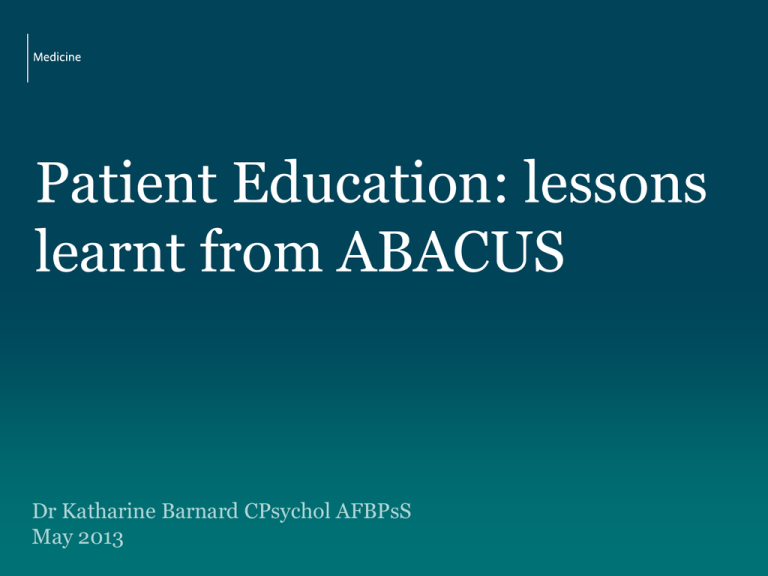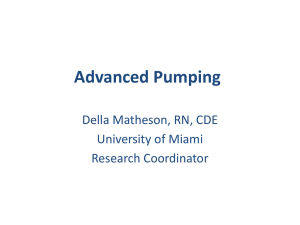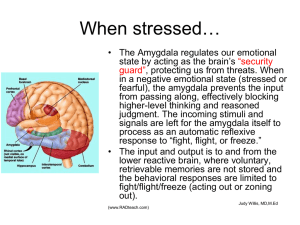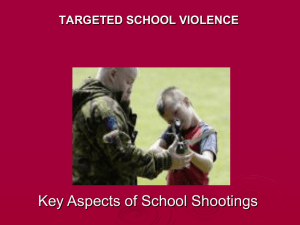Patient Education: lessons learnt from ABACUS, Dr Katharine Barnard
advertisement

Patient Education: lessons learnt from ABACUS Dr Katharine Barnard CPsychol AFBPsS May 2013 Imagine • You have a puzzle that you cannot solve • Every day you think carefully about the puzzle but there is no solution • Some days the solution to the puzzle is tantalisingly close • Other days the solution is elusive • You ask others if they have the solution but they do not Imagine • If you had to live life like this every single day ... • For the rest of your life … • And that your life depended on … your being able to solve that puzzle Sword of damocles • Go blind • Foot amputation • Kidney failure • Cardiovascular disease Burden of Diabetes People feel: • Isolated • Lonely • Ugly • Afraid • Burned-out Bolus Calculations • You have insulin treated diabetes • You eat carbohydrates • You need an insulin bolus every time you eat CHO’s • You have an I:CHO ratio, an ISF and a target range Example One • Current blood glucose = 5.5 • I:CHO ratio = 1 unit of insulin for 10g CHO • ISF = 1 unit of insulin to reduce by 2 • Target range = 4-7 • 100g CHO meal Example One • Current blood glucose = 5.5 • I:CHO ratio = 1 unit of insulin for 10g CHO • ISF = 1 unit of insulin to reduce by 2 • Target range = 4-7 • 100g CHO meal • Units of insulin required = 10 units Example Two • Current blood glucose = 5.5 • Add exercise after meal = 60 minutes • 60 minutes’ exercise will drop bg by 6 • I:CHO ratio = 1 unit of insulin for 10g CHO • ISF = 1 unit of insulin to reduce by 2 • Target range = 4-7 • 100g CHO meal Example Two • Current blood glucose = 5.5 • Add exercise after meal = 60 minutes • 60 minutes’ exercise will drop bg by 6 • I:CHO ratio = 1 unit of insulin for 10g CHO • ISF = 1 unit of insulin to reduce by 2 • Target range = 4-7 • 100g CHO meal • Units of insulin required = 7 units Let’s Be More Realistic • What if: • Current bg level is 9.3 • I:CHO ratio = 1 unit of insulin for 8g CHO • Meal contains 67g CHO • Doing 45 minutes of exercise • ISF = 1 unit to reduce by 2 • How many units now? Let’s Be More Realistic • What if: • Current bg level is 9.3 • I:CHO ratio = 1 unit of insulin for 8g CHO • Meal contains 67g CHO • Doing 45 minutes of exercise • ISF = 1 unit to reduce by 2 • Units of insulin required = 7.5 units Maths Check “I tried to check the maths. I have grade A "A level" maths (passed with 100%) and was originally accepted to Cambridge to study physics and despite this, when I checked your numbers, I felt overwhelmed and went to pieces and honestly can't do the sums”. 13 Margin of Error • ‘Best guess’ approach • ‘Little bit wrong’ every bolus dose • What would be the cumulative effect of all of those errors? Hidden Difficulties • 45% of UK adults have only primary school maths (aged >10 yrs) • Approximately 20% of adults lack basic numeracy skills • Diabetes is non-discriminatory • GCSE maths (aged 16 yrs) is required to calculate a bolus dose accurately • CHO counting alone is insufficient Does Use of an Insulin Bolus Advisor Improve Glycemic Control in Patients Not Achieving Optimal Control Using MDI? Results of the Automated Bolus Advisor Control and Usability Study (ABACUS) Ralph Ziegler, David A. Cavan, Iain Cranston, Katharine Barnard, Jacqueline Ryder, Claudia Vogel, Christopher G. Parkin, Walter Koehler, Iris Vesper, Bettina Petersen, Matthias Axel Schweitzer, Robin S. Wagner Manual Bolus Calculation Creates Obstacles for Patients • Discourages adherence to therapy: – Manual bolus calculation is complex, difficult, time-consuming, and requires mathematical skills and competence in carbohydrate counting – Patients may skip a bolus or rely on empirical estimates, which can lead to severe clinical consequences1,2 • Compromises patient safety: – Manual calculation does not account for the effect of active insulin remaining from previous bolus, which can lead to inappropriate “stacking” of boluses, resulting in hypoglycemia3 1. Pickup J et all. Diabetes Care 2002;25:593-598. 2. Bode BW et al, Diabetes Metab Res Rev 2002;18 (Suppl 1):S14-S20. 3. DeWitt DE and Hirsch IB. JAMA 2003;289(17):2254-2264. Study Overview • Primary Objective: – Determine if use of an insulin bolus advisor improves glycemic control • Study Goal: – Decrease HbA1c by >0.5% in each participant • Secondary Objectives: – Improvements in glycemic variability – Bolus advisor use and adherence to MDI rules – Changes in psychosocial factors – Frequency and severity of hypoglycemia Accu-Chek® Aviva Expert The Accu-Chek® Aviva Expert blood glucose meter: • Contains an integrated bolus advisor • Presents meal and correction bolus recommendations based upon current bG value, planned CHO intake and patient-specific therapy parameters stored in the device • Stores blood glucose and meal information in an electronic diary Study Protocol • All Participants – 6-month randomised trial using Accu-Chek Aviva Expert meter (EXP) vs Accu-Check Aviva Nano (CNL) – Baseline CHO Counting/MDI competency assessments and remedial training based on identified deficits (knowledge/DAFNE plates) – Psychosocial Assessments at baseline and study end – Structured SMBG (3-Day, 7-Point Profiles) at beginning, midpoint and end of study – SMBG data downloaded and reviewed at every visit to adjust treatment parameters – Continuous Glucose Monitoring (CGM) in “blinded” mode (approximately 50% of subjects) at beginning, midpoint and end of study Study Timeline Total intervention is 24 weeks Visit 1 Visit 3 Visit 5 Screening Start Start CGM BA 0 Visit 2 Train and Randomize Visit 4 Tx Check (phone) Visit 7 Visit 9 Therapy Check Therapy Check Study End 4 12 24 Visit 6 Start CGM Visit 8 Visit 10 Start CGM Type 1 and Type 2 >7.5 HbA1c MDI Therapy Training in MDI/CHO Counting within past 2 years Call Interventions • Control Participants (CNL) – Monitored blood glucose and manually calculated bolus insulin dosages based on test results – Insulin dosage parameters were checked/adjusted at all visits • Intervention Participants (EXP) – Monitored blood glucose and used Bolus Advisor to calculate bolus insulin dosages – Insulin dosage parameters in Bolus Advisor were checked/adjusted and updated in device at all visits Participant Disposition Screened n=229 Drop-outs n=11 8 eligibility not met 3 withdrew consent Randomized n=218 Control Intervention n=113 n=105 Drop-outs n=20 9 withdrew consent 4 noncompliant 3 withdrew consent and noncompliant 1 surgery/illness 3 lost to follow up/other Drop-outs n=5 Completers Completers n=93 n=100 2 noncompliance 1 withdrew consent and noncompliant 1 surgery/illness 1 pregnancy %Completers Achieving >0.5% HbA1c Reduction All Completers • Bolus advisor use was associated with a 63% greater chance for achieving HbA1c reduction of >0.5% • Average HbA1c reduction of -1.2% in both groups Glycemic Variability (CGM) Mean Amplitude of Glucose Excursion (MAGE) 3-Day Profile Days: All CGM Completers Changes in MAGE correlated with SD of glucose values (r = 0.87) and were independent of education level, diabetes duration, duration of MDI and gender Frequency of bG <50 mg/dL / 2.8 mmol/L Values <50 mg/dL / 2.8 mmol/L (%) All Completers 8 p=0.5880 p=0.1251 p=0.0764 p=0.0519 p=0.4698 p=0.1639 p=0.8876 p=0.8703 50 75 86 90 85 91 85 91 85 91 86 91 86 92 7 6 5 4 3 2 1 0 -1 N= 86 92 V1-2 V2-3 V3-4 Control V4-5 V5-6 V6-7 V7-8 V8-9 Intervention Use of the Bolus Advisor not associated with increased frequency of severe hypoglycemia CHO and MDI Knowledge Assessments and Checklists CHO and MDI Knowledge Association with Baseline HbA1c High competency (Perfect Score) in CHO/MDI knowledge was associated with lower HbA1c values 28 Carbohydrate Counting Assessment DAFNE Plates CHO Counting Competency Completers Control (N=113) Baseline 1.6 (10.1) / 14.6 (9.7) MME (Accuracy) g MMAE (Variability) g V9 1.0 (9.7) / 13.3 (9.9) Intervention (N=105) Baseline 1.0 (10.1) / 15.2 (9.0) V9 0.3 (7.1) / 12.4 (7.3) Significant improvement in MMAE (- 2.8 (8.2), p<0.01) and a trend towards improvement in MME in the EXP group but no change in CNL Use of MDI Rule Sets Control Patient-recorded bolus calculations from 3-day profiles were checked to determine if their stated I:CHO and ISF rules were used in a mathematically correct manner for each bolus calculation Bolus Advisor Utilization Intervention All (n=105) Advice used during study (SD), % 73.5 (21.9) Advices sought per day (SD), n 2.8 (1.2) Advices accepted per day (SD), n 2.5 (1.1) Advices modified per day (SD), n 0.3 (0.5) Doses adjusted up per day (SD), n 0.1 (0.2) Doses adjusted down per day (SD), n 0.2 (0.4) • High percentage of use, overall; however daily frequency of advice sought decreased significantly (-0.2 per day, p<0.01) by study end • Patients were twice as likely to reduce their insulin vs. increase dose Bolus Advisor Utilization Changes of Parameters • Significantly more EXP than CNL patients had changes in their insulin sensitivity factor (ISF) settings at Week 4 (24.5% vs. 10.8%, p<0.05) and Week 12 (29.3% vs. 8,6%, p<0.01). • The number of different ISF settings used during the day were increased significantly in EXP vs. CNL patients at all visits (p<0.05). • The number of ISF settings significantly increased longitudinally from baseline to study end in EXP but not CNL patients (p<0.05). • The number of changes in I:CHO settings showed a similar not statistically significant trend, with more EXP than CNL patients receiving I:CHO changes at Week 4 (35.7% vs. 25.8%, p=NS) and Week 12 (44.4% vs. 33.0%, p=NS). • The number of I:CHO settings significantly increased longitudinally in EXP but not CNL patients from the start to the end of the study (p<0.05). Treatment Satisfaction Improvement in DTSQ score from Baseline: Completers • EXP patients reported significantly greater improvement in treatment satisfaction from baseline than CNL patients • Baseline for CNL and EXP: 27.9 (6.1) vs. 28.0 (6.1); p=NS Summary • More EXP participants achieved >0.5% HbA1c reduction than CNL • Use of Bolus Advisor was a/w reduced glycemic variability but not higher frequency of severe hypos • Overall, participants sought/accepted bolus advice around 75% of the time • Participants using manual bolus calculation followed their “Rule Sets” only 26% to 47% of the time • Use of bolus advisor is a/w improved CHO competency • Participants who used the bolus advisor had more frequent changes in and more different I:CHO and ISF parameters Key Messages • CHO-counting and MDI skills at baseline are variable (despite education – so should such education include an assessment of skills learnt?) • There was an improvement in CHO estimation in the Expert group and an overall benefit in the Expert group • Bolus calculators can facilitate greater diabetes control • People use devices differently - use should ‘best fit’ with individual needs and personal circumstances Key Questions: • Do people with diabetes really understand and value the importance of accurate CHO counting? • How easy is it to fit accurate CHO counting into daily living realistically? • Do we support self-efficacy in CHO counting in the personal context of diabetes? • Is it possible to put education into context of everyday living against competing priorities? Diabetes Puzzle Still looking for the answer! k.barnard@soton.ac.uk






